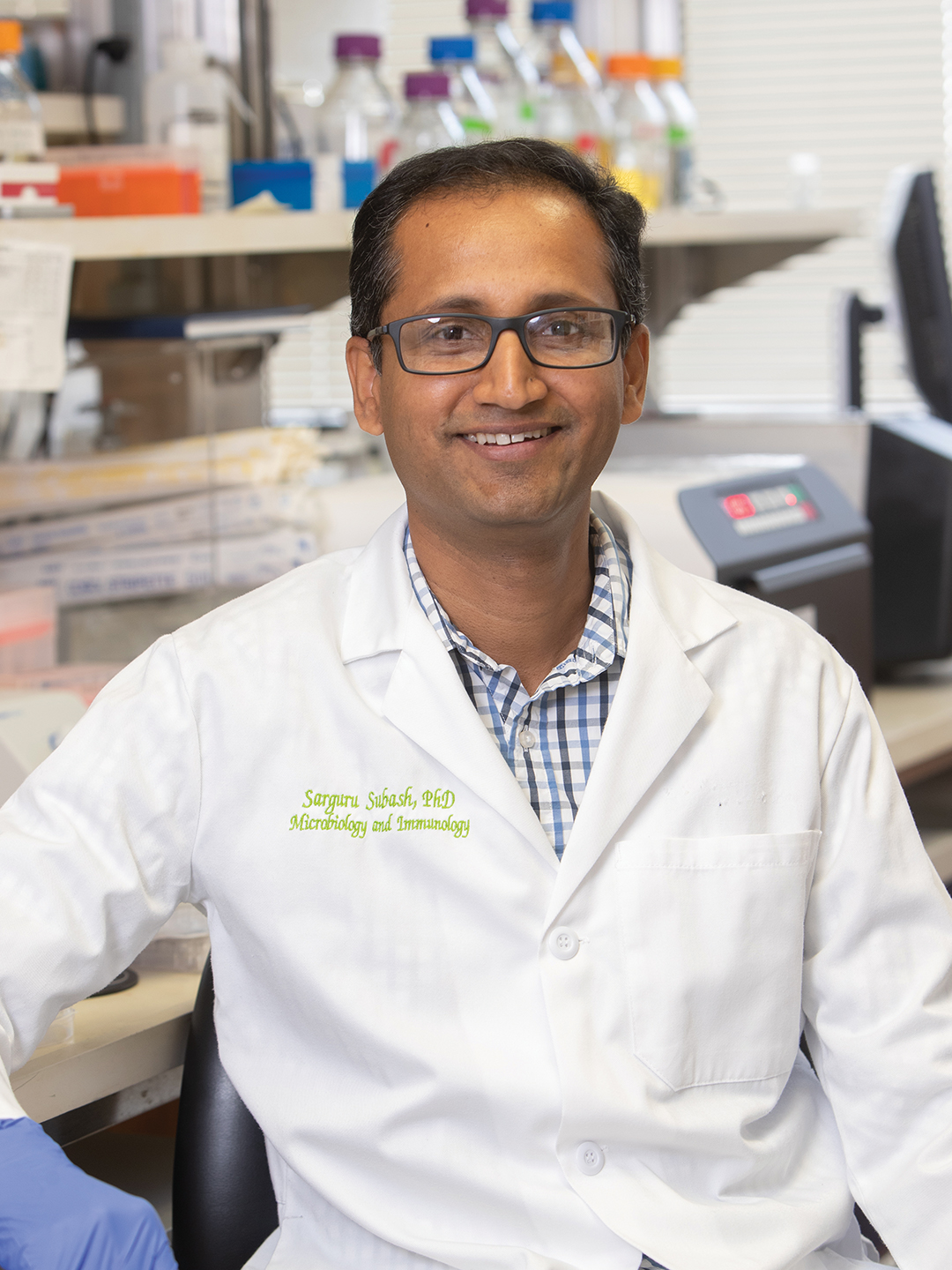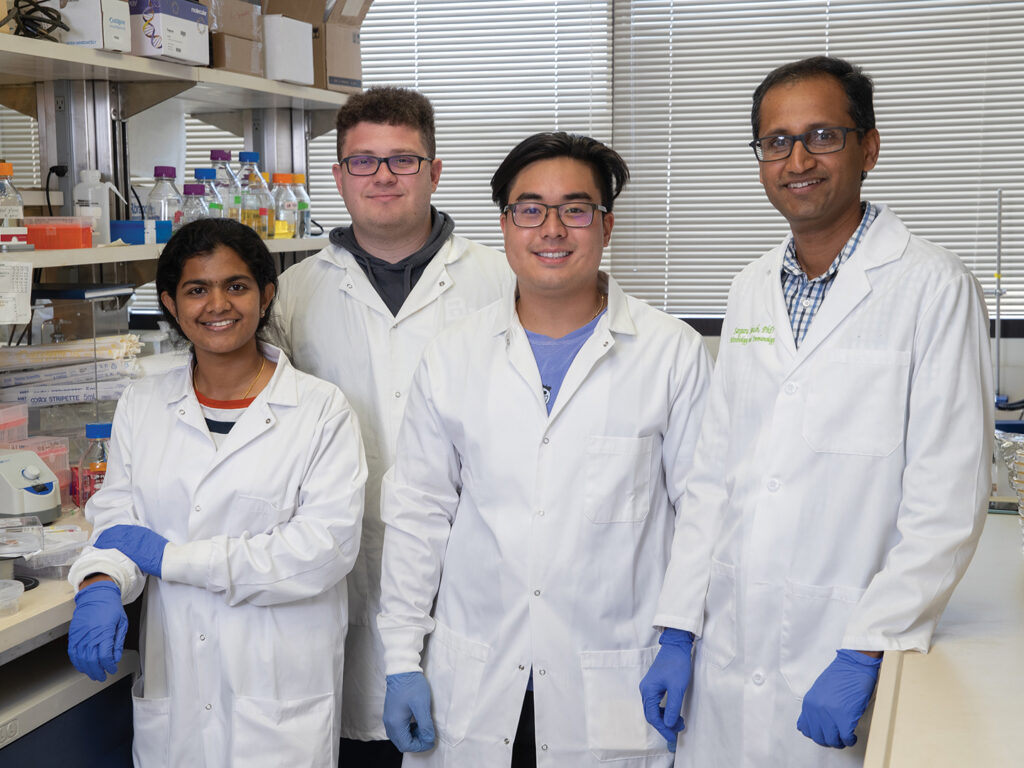VMBS Researcher Developing Novel Approaches To Treat Urinary Tract Infections, Avoid Antibiotic Resistance
Story by Madison Semro

If you wake up with a persistent urge to run to the restroom and a burning sensation when you urinate, you may have a urinary tract infection (UTI). If you do, your doctor will likely prescribe you a dose of antibiotics and send you home, assuring you that you will be just fine.
But that solution may not work if the bacteria causing the UTI are resistant to antibiotics.
Some doctors have found that certain antibiotics are no longer enough to eliminate infections caused by antibiotic-resistant bacteria, making those infections particularly dangerous to patients. As bacteria become more resistant to current antibiotic treatments, options for dealing with these infections are becoming fewer and fewer.
“Right now, it’s pretty scary,” said Dr. Sarguru Subash, an associate professor in the Texas A&M School of Veterinary Medicine & Biomedical Sciences’ (VMBS) Department of Veterinary Pathobiology (VTPB). “We are almost looking at a post-antibiotic world, where we may not be able to use antibiotics anymore like we used to do in the past.”
Revol-UTI-onizing Antibiotic Treatment
Subash and his lab group have honed in on studying UTIs, which occur when bacteria in the urinary tract multiply and lead to inflammation. UTIs are some of the most common bacterial infections in the world, responsible for more than 8 million doctor visits per year in the United States alone, and, in some cases, can lead to kidney damage and life-threatening complications.
Because these infections are common in several mammalian species, UTIs are a great model infection for Subash and his team as they work to understand both the extremely common infection and how bacterial infections function more broadly.
As with many other bacterial infections, antibiotics are the primary treatment methods for UTIs. However, just like with other antibiotics, antibiotic resistance is limiting how effective this treatment is for afflicted patients.
Decades of past research have shown that this resistance can occur very quickly — sometimes within the course of a few weeks; once this resistance has developed, it cannot be undone and, in its most extreme cases, can render a specific antibiotic useless.
So, Subash and his team are currently working toward developing a host-directed therapy — a treatment method that circumvents the development of antibiotic resistance and can positively impact both human and animal health.
By targeting the immune system, which has innate mechanisms to fight infections, and helping it do its job better, host-directed therapies would allow physicians to treat bacterial infections without needing to use an antibiotic. These treatments should give the immune system the boost it needs to be able to eradicate the infection on its own.
“I’m very excited about the concept of host-directed therapy, and that’s the area in which I see myself 10 years from now,” Subash said.
A Therape-UTI-c Approach
Host-directed therapies work like traditional antibiotics; these therapies rely on the host’s response to a pathogen rather than affecting the pathogen directly, such as by changing the environment in which the pathogen exists to make it less favorable to live or grow.
An example of this is the body’s use of metals such as copper; many animals, including human beings, rely on copper when carrying out important processes in the immune system. When infected by a pathogen, the immune system can restrict life-sustaining metals from the bacteria, and at the same time, it can pump copper, which is toxic to bacteria, into the bacteria’s cells.
This mechanism of simultaneously depriving the bacteria of essential metals and pumping copper into the bacteria allows the host’s immune system to prevent the infection from spreading, possibly even killing the infection altogether.
Previous research has established that a protein named ceruloplasmin releases more copper in the urine during UTIs, but there is still much to learn about the exact mechanisms of copper in immune functions.
“We are almost looking at a post-antibiotic world, where we may not be able to use antibiotics anymore like we used to do in the past.”
Dr. Sarguru Subash
In the next few years, Subash and his team aim to determine how copper is getting into the bladder during UTIs so they can boost this specific aspect of the immune response — a clever idea to outsmart antibiotic resistance.
“To specifically target one host immune effector and see therapeutic outcomes of boosting a host immune response, that’s something that we are actually unique in and that sets us apart from some of the best of the UTI research community,” Subash said.
The novel treatment method Subash is working toward would allow physicians to treat bacterial infections without fear of contributing to the development of antibiotic-resistant strains.
Because their alternative could lead to fewer secondary infections, and, thus, improve patient outcomes, Subash and his team are currently supported by grants from the National Institutes of Health.
“If we did detect a specific receptor or a transporter within that cell type that’s involved in the mobilization of copper, then we can pharmaceutically modify how much copper is released into urine,” Subash explained. “Then, we can play with the modulating site during infection, so we can make it less hospitable for bacteria to grow.”
Evol-UTI-on From Veterinarian To Researcher
Subash’s interest in veterinary medicine began at a young age on his grandparents’ farm in a small town in southern India, where he helped care for the animals. That interest drove Subash to attend veterinary school at Madras Veterinary College of Tamil Nadu Veterinary and Animal Sciences University in India, where he learned that he also had a passion for science.
“Very soon, I realized that by studying animal health, we can address more broad problems in human health as well,” Subash said. “So, it took me away from practicing veterinary medicine more into hands-on science and research.”
Subash moved to the United States to pursue his Ph.D. in comparative medicine and integrative biology at the Michigan State University College of Veterinary Medicine, which he completed in 2011. There, he said he got his first real research experience.
Following his Ph.D., he started to look at potential pathogens and infection models that could impact both human and animal health in a wide-reaching way.
“That’s when UTI research really caught my attention. It’s a very broadly applicable disease that can still help me retain some aspects of connection to my previous life as a veterinarian by addressing a problem that is relevant to human and animal health,” Subash said.
Subash then completed a postdoctoral fellowship under Dr. Harry Mobley at the University of Michigan Medical School, where he began studying UTIs. In 2015, he completed his fellowship and got his first faculty position at the Wake Forest University School of Medicine.
But Subash felt that something was missing in the medical school environment; he had wanted to eventually get back to his veterinary roots, so he decided to move to Texas A&M, where he could work on developing biochemical and genomic approaches to address his research questions about UTIs.
Contrib-UTI-ng To The Future

Since joining the Texas A&M faculty in 2018, Subash has become an integral member of the Aggie community.
“We recruited Dr. Subash for his top-quality research program in infectious diseases and his passion for mentoring the next generation of scientists,” said Dr. Ramesh Vemulapalli, VMBS executive associate dean and former VTPB department head. “His research and teaching accomplishments have been outstanding.”
Each spring, Subash teaches a graduate-level course called Bacteria in Health and Disease about the various impacts bacteria can have on different organ systems. He also mentors students in his classroom and his research lab.
“Mentoring is something that is very close to my heart because I benefited tremendously from having great mentors in graduate school and during post-doctoral training,” he said.
Subash takes an individualized approach to working with students, meeting them where they currently are and helping to fill in their gaps. Whether they require training in laboratory techniques or help writing grant proposals, Subash is happy to help — and if he can’t, he will connect his students with someone who can.
“For every student, my mentoring style is trying to understand what they’re comfortable with, what their strengths are, what their weaknesses are, and developing a personalized mentoring philosophy,” Subash explained. “I don’t have a boilerplate approach to mentoring because I don’t think it will work. So, it’s trying to find out what they need and also being flexible.”
That mentorship style is exactly what drew Kaitlin Casanova-Hampton, who recently completed her Ph.D., to join Subash’s lab when she started graduate school in 2018. Casanova-Hampton was interested in microbiology and signed up in Subash’s lab to fill her last rotation spot.
After spending time in the lab, however, she knew she found the ideal mentor in Subash.
“When it comes to your Ph.D. program, finding a principal investigator with whom you are on the same page is the most important decision you can make,” Casanova-Hampton said. “It was really important to me to find somebody who cared about my personal well-being. I knew that since I was having a family, having somebody who cared about me as a person, as opposed to what I could do for them, was everything.”
Casanova-Hampton became Subash’s first student to earn her Ph.D. During her four years in graduate school, she published three papers, presented at conferences, and went on maternity leave — twice — to start her family.
“Because of Dr. Subash, I had a supreme grad school experience,” she said. “I was able to check all of the boxes, all while still being able to check a lot of personal boxes.”
Casanova-Hampton said Subash’s kindness and understanding are what make him a great mentor; by combining these qualities with his scientific expertise, he can be whatever his students need him to be, fostering strong relationships and creating a supportive lab environment.
“Dr. Subash is really great about putting the needs of the lab first but also putting my needs as an individual first as well,” she explained. “He tries to make it to where everybody’s winning — where a win for the lab is a win for me, too.”
###
Note: This story originally appeared in the Winter 2023 edition of VMBS Today.
For more information about the Texas A&M College of Veterinary Medicine & Biomedical Sciences, please visit our website at vetmed.tamu.edu or join us on Facebook, Instagram, and Twitter.
Contact Information: Jennifer Gauntt, Director of VMBS Communications, Texas A&M College of Veterinary Medicine & Biomedical Sciences; jgauntt@cvm.tamu.edu; 979-862-4216


